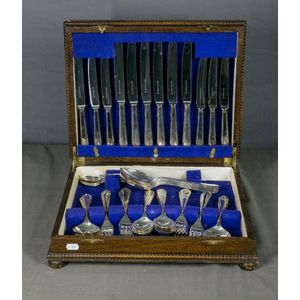Floral Fruit Set in Mother-of-Pearl and Silver Plate
A boxed Mother-of-pearl and silver plate fruit set, early 20th century, with maker's marks for Frederick Asman & Co. Sheffield, a setting for twelve, comprising knife blades well decorated with bright cut flowers and scrolls, embossed ferrules to tapering mother-of-pearl handles, cased in a velvet and silk lined mahogany box. Lengths 20 cm and 16.5 cm
You must be a subscriber, and be logged in to view price and dealer details.
Subscribe Now to view actual auction price for this item
When you subscribe, you have the option of setting the currency in which to display prices to $Au, $US, $NZ or Stg.
This item has been sold, and the description, image and price are for reference purposes only.
- Mother-Of-Pearl - Mother-of-pearl, technical name "nacre", is the inner layer of a sea shell. The iridescent colours and strength of this material were widely used in the nineteenth century as an inlay in jewellery, furniture, (especially papier mache furniture) and musical instruments.
In the early 1900s it was used to make pearl buttons. Mother-of-pearl is a soft material that is easily cut or engraved.
Nowadays it is a by-product of the oyster, freshwater pearl mussel and abalone industries. - Mahogany - Mahogany is a dense, close grained red-coloured timber from the West Indies and Central America. It was first imported into Europe in the the early 18th century and its use continued through the 19th century. It was popular for furniture making because of its strength, the wide boards available, the distinctive grain on some boards, termed flame mahogany and the rich warm colour of the timber when it was polished.. The "flame" was produced where a limb grew out from the trunk of the tree, and this timber was usually sliced into veneers for feature panels on doors, backs and cornices.
Some terms used to describe mahogany relate to the country from which it originally came, such as "Cuban" mahogany, "Honduras" mahogany etc. However unless the wood has been tested the names assigned are more a selling feature, rather than a true indication of the timber's origin. - Embossed / Repousse - Embossing, also known as repousse, is the technique of decorating metal with raised designs, by pressing or beating out the design from the reverse side of the object.It is the opposite of chasing, where the decoration is applied from the front. An embossed or repoussed object may have chasing applied to finish off the design.
Visually similar items

Silver plate cutlery service 'Grosvenor' in original box, approx 50 cm long, 29 cm wide
Sold by
in
for
You can display prices in $Au, $US, $NZ or Stg.

Victorian 24 piece set hallmarked sterling silver fruit cutlery. Birmingham 1875. Makers George Unite. Wood cased
Sold by
in
for
You can display prices in $Au, $US, $NZ or Stg.

Boxed 46 piece Walker & Hall silver plated canteen of cutlery. Settings for 6, plus four serving spoons.
Sold by
in
for
You can display prices in $Au, $US, $NZ or Stg.

Canteen of silver plated cutlery 8 place settings & 2 servers
Sold by
in
for
You can display prices in $Au, $US, $NZ or Stg.
